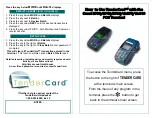
PS-SAU-1900E
Mar. 8
th
,1999 (Rev. 0.0)
--- CONFIDENTIAL AND PROPRIETARY ---
22
interspersed at various locations throughout the controller software package, which is resident in flash
memory on the Digital Module. This memory also contains the operating software used by the
Qualcomm MSM ASIC.
The two major functional parts of the telephone interface consist of the application-specific hardware
interface, and the Central Office emulation software. Each will be described in the following sections.
3.1.1.
Telephone Interface State Diagram.
The state diagram for the Telephone Interface software is shown below.
The function of the software sub-states are generalized as follows:
INITIALIZE State:
The LAU’s MSM controller unit reads in E
2
PROM
configuration data, and then performs various operations
necessary to set up the LAU’s hardware interfaces.
ACQUIRE SYSTEM State:
This state is actually a major state within the Qualcomm
MSM operating code. Upon power-up of the unit, the
LAU’s MSM hardware and software perform a number of
functions to initialize the system. Once initialized, the unit
begins searching for an appropriate CDMA base station.
Once the b/s is located, the LAU registers with the station,
and moves to the IDLE state. IDLE state is reached once
Figure 3.1.1.a. - Telephone Interface State Diagram.
IDLE
State
CONFIG &
TEST
State
POWER
CHANGE
State
FAULT
State
OUTGOING
CALL
State
SYSTEM
LOST
State
INCOMING
CALL
State
ACQUIRE
SYSTEM
State
INITIALIZE
State
ALERT = True
TERMINATION = True
TERMINATION = True
OFF_HOOK = True
SIO_INTRPT = True
INIT_DONE = True
SYS_AQD = False
SYS_AQD = True
CONFIG_DONE = True
SYS_LOST = True
OFF_HOOK= True
















































